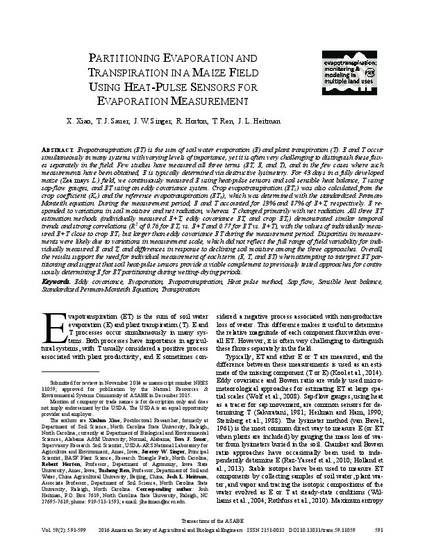
Evapotranspiration (ET) is the sum of soil water evaporation (E) and plant transpiration (T). E and T occur simultaneously in many systems with varying levels of importance, yet it is often very challenging to distinguish these fluxes separately in the field. Few studies have measured all three terms (ET, E, and T), and in the few cases where such measurements have been obtained, E is typically determined via destructive lysimetery. For 43 days in a fully developed maize (Zea mays L.) field, we continuously measured E using heat-pulse sensors and soil sensible heat balance, T using sap-flow gauges, and ET using an eddy covariance system. Crop evapotranspiration (ETc) was also calculated from the crop coefficient (Kc) and the reference evapotranspiration (ETo), which was determined with the standardized Penman- Monteith equation. During the measurement period, E and T accounted for 13% and 87% of E+T, respectively. E responded to variations in soil moisture and net radiation, whereas T changed primarily with net radiation. All three ET estimation methods (individually measured E+T, eddy covariance ET, and crop ETc) demonstrated similar temporal trends and strong correlations (R2 of 0.76 for ETc vs. E+T and 0.77 for ET vs. E+T), with the values of individually measured E+T close to crop ETc but larger than eddy covariance ET during the measurement period. Disparities in measurements were likely due to variations in measurement scale, which did not reflect the full range of field variability for individually measured E and T, and differences in response to declining soil moisture among the three approaches. Overall, the results support the need for individual measurement of each term (E, T, and ET) when attempting to interpret ET partitioning and suggest that soil heat-pulse sensors provide a viable complement to previously tested approaches for continuously determining E for ET partitioning during wetting-drying periods.
Available at: http://works.bepress.com/robert-horton/16/

This article is from Xiao, X., T.J. Sauer, J.W. Singer, R. Horton, J.L. Heitman, and T. Ren. 2016. Partitioning evaporation and transpiration in a maize field using heat pulse sensors for evaporation measurement. Transactions of the ASABE 59:591-599. doi: 10.13031/trans.59.11059.